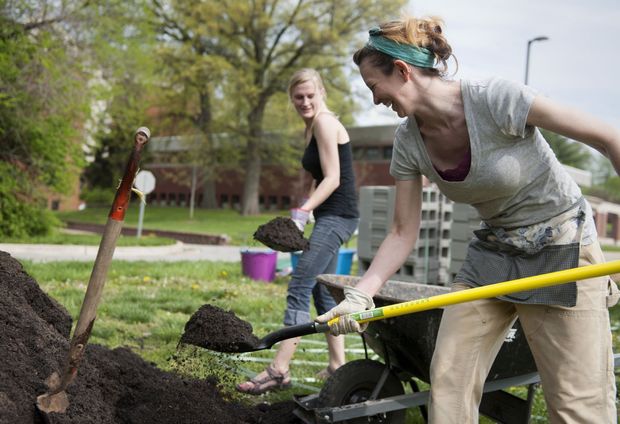By Koran Addo
St. Louis Post-Dispatch.
Crowdfunding is everywhere, with musicians, filmmakers and entrepreneurs financing projects through the small donations of friends and strangers.
So it shouldn’t be surprising that universities should get in on the action.
After all, college is the place where ambitious people with big ideas are supposed to nurture their talent before going off and doing important things.
It’s also a place where private donations are counted on to do the kinds of things that tuition and tax funding cannot.
And in the future economy, the know-how to run a successful crowdfunding campaign may become an essential skill.
The University of Missouri-St. Louis launched a new crowdfunding website in February, offering students an outlet to solicit funding for projects. Campaigns on the site include scholarships, a community garden, and an effort to help students find jobs.
College students are already turning to crowdfunding to raise money for school and study abroad, using sites such as gofundme.com.
But with official university sites such as UMSL’s, students also have the expectation of appealing directly to the university’s alumni.
And that has the potential of changing campus giving.
James Page, assistant director within UMSL’s Office of Alumni Engagement, said he’s found that people are more apt to donate to causes versus institutions. They’re looking for projects where they can see the direct, tangible benefits of their donations.
“It’s not about mass emails, it’s individualized asks,” he said.
buy cialis black generic buy cialis black online no prescription
So far, students have had mixed success.
The university’s marketing club came up about $1,000 short during its 30-day campaign to raise $6,700 to send its members to a conference in New Orleans.
Another group raising money to build a vegetable garden on campus came up more than $3,000 short of its goal during its campaign, but it’s still moving ahead with the money it did raise.
In contrast, the eight members of the homecoming court reached their goal of raising $8,000 in scholarship funds in less than a week.
Meanwhile, the Missouri University of Science and Technology in Rolla has started a crowdfunding website with the goal of raising $15,000 to send students to a Mars rover design competition in Krakow, Poland, this fall. On Tuesday, with nine days to go, that fund drive had reached and slightly exceeded its goal.
At UMSL, Page said the university’s crowdfunding site is reserved for helping student organizations meet their goals, not vanity projects.
He said crowdfunding helps augment funds the university already spends on student activities.
Student organizations — from the accounting club to the student newspaper — request $1 million in funding from the university each year. Typically, the university provides about half that amount, Page said.
“Our office saw this as a place we could help,” he said. “We approached different groups, and we asked them, ‘What project do you want to do but can’t because you don’t have the money?'”
Members of UMSL’s Catholic Newman Center are planning a service trip to Nicaragua.
Senior nursing student Kim Berry said each of the group’s 14 members set a goal of soliciting donations from 20 people to hit their $10,000 target.
After hitting a wall four days into their campaign, they began calling and emailing a list of university alumni they’d gotten from Page. The group eventually contacted 600 people before hitting their goal. In all, 99 donors contributed a total of $10,885.
“This was really in doubt in the beginning, but eventually people started responding,” Berry said.
Across campus, The Current, UMSL’s student newspaper, is just days from the end of a 30-day campaign seeking $10,000 to keep the paper afloat. It still needed almost $3,000 as of Tuesday night.
Anna Glushko, The Current’s editor-in-chief, said UMSL and the Student Government Association has reduced funding for the newspaper from $40,000 to zero dollars over three years.
The newspaper is also on the hook for debt accumulated under previous generations of student journalists.
For Glushko, who said the university’s lack of funding for the newspaper came as a complete surprise, the outcome of The Current’s $10,000 crowdfunding campaign is about the survival of an institution that’s been on campus since 1966.
“This is a really tough situation,” Glushko said. “We have to make it work.”
An industry report from crowdsourcing.org estimates that crowdfunding is now an estimated $16 billion enterprise, with business lending and charity some of the fastest-growing categories.
It’s unclear, what percentage of crowdfunding campaigns hit their marks, or the leading factors that ultimately lead to a successful venture.
Page, the assistant director in the Office of Alumni Engagement, said UMSL generally limits crowdfunding goals to 30 days.
That way, students stay actively engaged, posting on social media sites and sending emails throughout the campaign.
An added benefit for UMSL, Page said, is that students participating in such campaigns learn “the culture of philanthropy,” and could become future donors themselves.
“Universities are funded in large part by private donations,” he said.














































































































































































































































































































































































